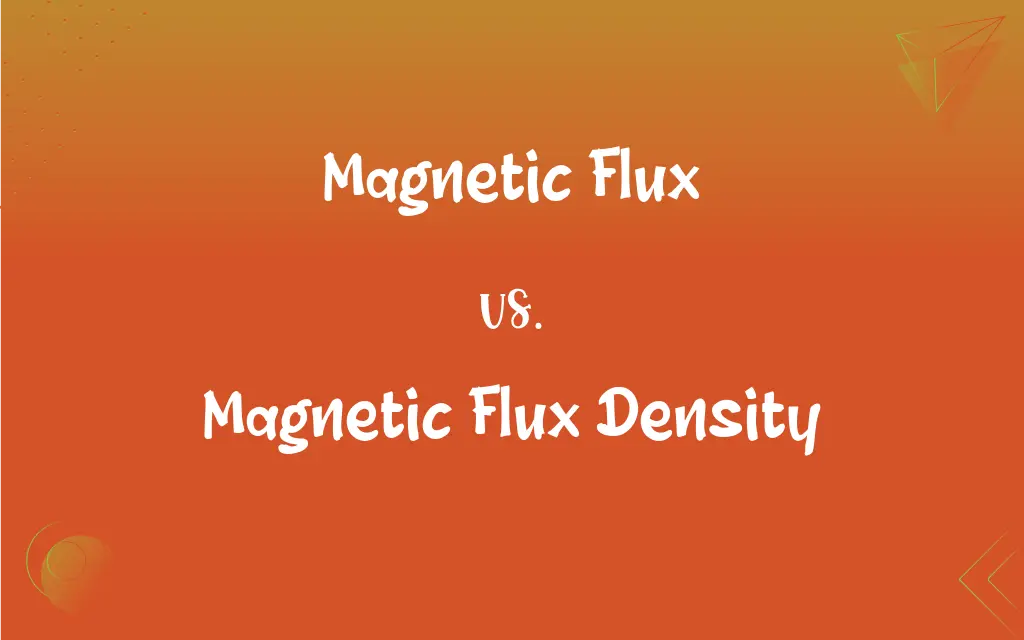Magnetic Flux vs. Magnetic Flux Density: What's the Difference?
Edited by Aimie Carlson || By Harlon Moss || Published on August 31, 2024
Magnetic flux measures the total magnetic field passing through an area, while magnetic flux density describes the field's strength per unit area.

Key Differences
Magnetic flux, symbolized by Φ (Phi), quantifies the total magnetic field passing through a given area, considering the field's strength and the area's orientation relative to the field. It is measured in webers (Wb) and is a scalar quantity, meaning it has magnitude but no direction. Magnetic flux density, on the other hand, is a vector quantity represented by B, indicating the strength and direction of the magnetic field at a point. Measured in teslas (T), it reflects how dense the magnetic field lines are in a particular area.
Magnetic flux gives a holistic view of the magnetic field through a specified area, magnetic flux density offers a more localized perspective, detailing the field's intensity at specific points within the area. This distinction is crucial in applications such as electrical engineering and physics, where understanding both the overall influence of a magnetic field (flux) and its local intensity (flux density) is essential for designing and analyzing magnetic systems.
In the study of electromagnetism, magnetic flux is often used to calculate induced electromotive force (EMF) in a loop or coil due to changing magnetic fields, as described by Faraday's Law of Electromagnetic Induction. Conversely, magnetic flux density is frequently employed in the analysis of magnetic materials and the design of magnetic circuits, where the local intensity of the magnetic field affects material behavior and circuit performance.
The concept of magnetic flux is integral to understanding transformers, electric motors, and generators, where the total magnetic field interacting with coils or windings is critical for their operation. Magnetic flux density, however, is more relevant in applications like magnetic resonance imaging (MRI) and particle accelerators, where precise control over the strength and direction of magnetic fields is necessary for functionality and accuracy.
Magnetic flux and magnetic flux density are both key parameters in the realm of magnetism, yet they serve different purposes and provide unique insights into magnetic fields and their effects.
ADVERTISEMENT
Comparison Chart
Definition
Total magnetic field through an area
Strength of magnetic field per unit area
Symbol and Unit
Φ (Phi), measured in Webers (Wb)
B, measured in Teslas (T)
Nature
Scalar quantity (magnitude only)
Vector quantity (magnitude and direction)
Usage
Used to calculate induced EMF, in transformers, etc.
Used in analyzing magnetic materials, MRI, etc.
Relation to Area
Considers the entire area and field orientation
Focuses on field intensity at specific points
ADVERTISEMENT
Magnetic Flux and Magnetic Flux Density Definitions
Magnetic Flux
The total magnetic field through a given area.
The magnetic flux through the coil increased as the magnet approached.
Magnetic Flux Density
Specific point measurement.
Magnetic flux density measurements help map the magnetic field around a current-carrying wire.
Magnetic Flux
Sum of magnetic lines of force passing through an area.
A larger surface area perpendicular to the magnetic field results in greater magnetic flux.
Magnetic Flux Density
Indicates both magnitude and direction.
The magnetic flux density vector pointed directly away from the magnet's north pole.
Magnetic Flux
Result of changing magnetic flux in a loop.
Faraday's law relates induced EMF to the rate of change of magnetic flux.
Magnetic Flux Density
Important in magnetic circuits and materials.
The magnetic flux density was critical in determining the material's saturation point.
Magnetic Flux
Magnetic flux unit.
An electromagnet produced a magnetic flux of 0.5 webers.
Magnetic Flux Density
Strength of magnetic field per unit area.
The magnetic flux density near the magnet's pole was particularly high.
Magnetic Flux
Represents magnitude without direction.
Magnetic flux, being a scalar quantity, does not indicate the magnetic field's direction.
Magnetic Flux Density
Unit of magnetic flux density.
An MRI machine operates at a magnetic flux density of 1.5 teslas.
FAQs
Is magnetic flux a vector quantity?
No, it's a scalar quantity.
What unit is used for magnetic flux density?
Teslas (T).
Can magnetic flux be negative?
Its value is not negative, but directionality is not applicable.
What is magnetic flux?
The total magnetic field passing through an area.
What is magnetic flux density?
The strength of the magnetic field per unit area.
What role does magnetic flux play in transformers?
It's key in transferring energy between coils.
Where is magnetic flux density crucial?
In MRI technology and magnetic material analysis.
Does changing magnetic flux induce EMF?
Yes, as per Faraday's Law of Electromagnetic Induction.
Is magnetic flux density a scalar or vector?
It's a vector quantity.
What affects magnetic flux?
Magnetic field strength, area size, and orientation.
How is magnetic flux measured?
In webers (Wb).
What's a practical use of magnetic flux?
In designing electric motors and generators.
Can magnetic flux density be uniform?
Yes, in ideal cases like inside a solenoid.
Is magnetic flux density directional?
Yes, it has both magnitude and direction.
How does area affect magnetic flux density?
Flux density focuses on field strength at a point, regardless of total area.
What's the relationship between magnetic flux and flux density?
Flux density is the flux per unit area.
How do you increase magnetic flux density?
By increasing the current or using a material with higher permeability.
How does the orientation of an area affect magnetic flux?
Flux is maximum when the field is perpendicular to the area.
What does a tesla represent in terms of magnetic flux density?
One tesla equals one weber per square meter.
How do materials affect magnetic flux density?
Materials with high permeability can concentrate magnetic flux, increasing density.
About Author
Written by
Harlon MossHarlon is a seasoned quality moderator and accomplished content writer for Difference Wiki. An alumnus of the prestigious University of California, he earned his degree in Computer Science. Leveraging his academic background, Harlon brings a meticulous and informed perspective to his work, ensuring content accuracy and excellence.
Edited by
Aimie CarlsonAimie Carlson, holding a master's degree in English literature, is a fervent English language enthusiast. She lends her writing talents to Difference Wiki, a prominent website that specializes in comparisons, offering readers insightful analyses that both captivate and inform.






































































